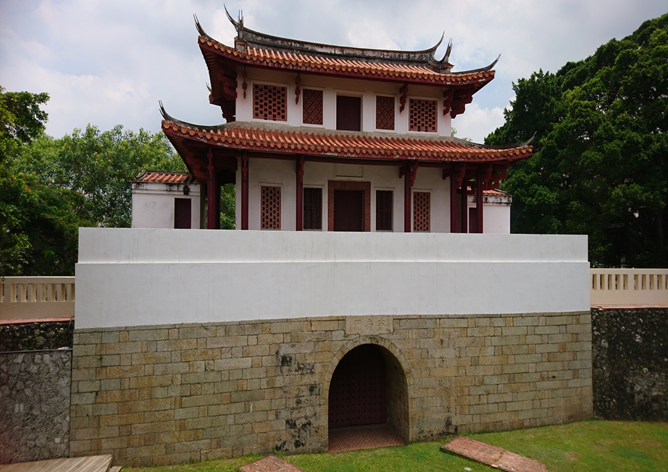

-
- 111th Academic Year
- The Avenue of NCKU Heritage – Area of Cultural Assets
- The Avenue of NCKU Heritage – Area of Environment and Ecology
- From country to city: Taveron and Han integration
- Kyrie: Pestilence and faith in the salty area
- Highlighting Western Chu-Wei
- Ginza: Commercial tracks from harbors to modern streets
- Tavocan and the Town of Hills
- The Museum: Ecological village and eco-museum
- The Stories about Major South Gate of Fu-Chen (Tainan)
- Modern new generation
- 110th Academic Year
- The Route of NCKU Students - The Cultural Assets Area
- NCKU Students' Route – Area of Cultural Assets
- Migration and Settlement of the Siraya Tribe
- Zengwen Creek’s nine bends and 18 turns, with astronomy, hydrology and humanities
- Exploring the Old Industries of Tainan City
- Journey of Beauty
- The Narrations of Water Resources, Agriculture and Livestock Industries
- Exploring Old Yuejin Harbor Area
- Lâu-Nuā Sió Sai Kha
- Highlighting Western Chu-Wei Area, Yu-Ler Street & Eastern Gate
- 109th Academic Year
- NCKU Students' Route – Area of Cultural Assets
- NCKU Students' Route – Area of Environment and Ecology
- Migration and Settlement of the Siraya Tribe
- Old Taijiang Inner Sea: Its Previous and Current Existence
- Lâu-noā Sió-sai-kha
- Exploring the Old Industries of Tainan City
- The Exploitation of the Works of Nature-Journey about The Frost and The Flower of Salt
- Badlands and the Mountain City
- Age-old Stories from the South of the City
- The Magnificent of Zheng-Xing Street
- 108th Academic Year
- The Route of NCKU Students─The Cultural Assets Area
- NCKU Students' Route – Area of Environment and Ecology
- Ecology of Fishery and Sea Salt Harvesting─ The Nature and Culture of Tai-Jiang Lagoon
- Migration and Settlement of the Siraya Tribe
- Age-old Stories from the South of the City
- Exploring the Old Industries of Tainan City
- The Narrations of Water Resources, Agriculture and Livestock Industries
- Technology and Humanities Science Park and Cultural Archeology
- From Kū-Lâu to Sin-Lâu Hospital
- Folk Delicacy around Minor West Gate Area
- 107th Academic Year
- The Avenue for NCKU Students
- Exploring Old Occupations in Tainan
- Secret Literary Path of Tainan
- Migration and Settlement of the Siraya Tribe
- Old Tai Jang Inner Sea: Its Previous and Current Existence
- Five-Canal Harbor Area: The Water Gods and Import-Export Tradesmen
- Tradition and Innovation: Zhengxing Street and the Grand Market(Da Caishi)
- The Water Resource of Tainan Area
- The Grace of Yanshui Harbor: Rejuvenation of Yanshui and Hopi Settlements
- 106th Academic Year
- The Avenue of NCKU Students
- Gate of Urn-Shaped Castle and the Stony Plates
- Siraya People’s Migration and Their Journey to Settlement
- Zeelandia and the Retrospective Anping
- Old Taijang Inner Sea (Taijang Nei Hai ) : Its Previous and Current Existence
- Tradition and Innovation- Zhengxing Street and the Grand Market (Da Caishi )
- Qing Dynasty Government Official’s Trail-Chunan Old Street and Zhenbei Fang
- Five-Canal Harbor Area, the Water Gods and Import-Export Tradesmen
- Fantastic Trips to Know Sugar and Salt production
- Chikan Park Area and Historical Traces
- Secret Garden of Literature- From Taiwan Administration (Taiwan Fu) to Tainan Prefecture Hall (Tainan Zhou Ting)
- The Water World of Tainan Area
- 111th Academic Year
-
-
-
Age-old Stories from the South of the City
Route Introduction

The Grand South Gate
It is a municipal historic site in Tainan City, and it is categorized as the city wall. The Grand South Gate of Granite City block, also known as Ning-Nan Gate, is a double-stories tower with East Asia's hip-and-gable roof. At the gate of the city, the old stone outer wall with a half-moon shape protrudes. The battlements are set on the city wall and the round-arched door below. There is a forest of ancient steles on the right side, and it is an important material for researching the history of Tainan City and an exquisite place for public people. The remaining Grand South Gate city is composed of an east-west inner city in the north and crescent-shaped in the south. The city wall is divided into two gates, The Ning-Nan gate is located in the center of the inner city, and The Grand South Gate is located in the southeast of crescent-shaped; on the Ning-nan gate, there is an East Asia's hip-and-gable roof building with two floors high and three rooms wide. Corridors surround the first floor, the buildings with a single bay and gable roofs on both sides, and have the same orientation as the gate tower, which should be the room for soldiers to rest or store weapons.
The Grand South Gate was the thoroughfare in Qing Dynasty from Tainan to the Feng-Shan area. It was originally built with wooden fences. After the 53rd year of Qian-Long (1788), it was rebuilt with cement and bricks. In the 15th year of Dao-Guang (1835), to strengthen the defense, an outer structure was built in the shape of a crescent. The enemy could be easily trapped and captured once they entered the structure the way turtles are caught in an urn that is why it was also called the urn city or barbican. Inside the city was a bustling wet market and a firewood market, and outside the city is Kui-Dou Hill covered with graves. In the 1930s, Japan created a park centering in this area and gradually changed the appearance inside and outside the city gate. The burial areas outside the city are now mostly used as school districts. However, in the deep historical atmosphere around the city gate, peoples can still find traces of the olden days.
-